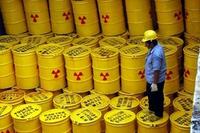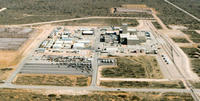-
Pressure grows for building a centralized nuclear waste repository
In 2010, after $9 billion and twenty-five years of construction, the Obama administration pulled the plug on the Yucca Mountain centralized nuclear waste repository. Toxic nuclear waste continues to accumulate on the grounds of U.S. nuclear power plants, with concerns growing about the security of keeping so may tons of such toxic materials in such a dispersed manner. Concerns have been heightened lately by the wave of closing, for economic reasons, of nuclear power plants, and worries about the safety of radioactive waste remaining behind on the grounds of shuttered plants. Senate Bill 1240 calls for the development of a Nuclear Waste Administrationto take responsibility for transporting and storing nuclear waste, and find the right geological location for a new centralized repository.
-
-
Cracked lid of a nuclear waste container may be source of WIPP radiation leak
The radiation leak at the Waste Isolation Pilot Plant (WIPP) near Carlsbad, New Mexico has been linked to a waste container shipped from Los Alamos National Laboratory (LANL), raising questions about the safety of other containers stored at the lab’s northern New Mexico facility and at the Waste Control Specialists (WCS) site in Andrews, Texas.As a precautionary measure, LANL has been ordered to remove thousands of similar containers filled with toxic waste from outdoor storage. Critics of nuclear waste storage practices have blamed the recent radiation accidents on a diminishing culture of safety at the fifteen-year-old WIPP.
-
-
Safety of nuclear waste storage questioned

The aftermath of the Hiroshima and Nagasaki bombings, and the Chernobyl accident, offers proof that high doses of radiation can have pernicious effects on plant and animal life. The largest human-made radiation risk, however, lies in nuclear waste stored near reactors or in underground repositories like the Waste Isolation Pilot Plant(WIPP) in Carlsbad, New Mexico.
-
-
New Mexico demands clarifications, reassurances on WIPP radiation leaks

New Mexico’s environment secretary Ryan Flynn has ordered the Department of Energy (DOE) to explain how it will protect public health and the environment while it investigates a radiation leak at the underground Waste Isolation Pilot Plant (WIPP). The plant has not been in compliance with various permit requirements since the February underground fire and radiation leak, which eventually led to a plant shutdown.
-
-
Problems continue to plague the Oxide Conversion Facility at Y-12

Oxide conversion is critical to recycling weapons-grade uranium, making it useful in nuclear warheads or for other purposes. The Oxide Conversion Facility (OCF) at the Y-12National Security Complex has been operating inconsistently in recent years. A report by the staff of the Defense Nuclear Facilities Safety Board(DNFSB) said there was a plan to resume operations the week of 7 April 2014, but that did not happen.
-
-
Absorbent used in kitty litter may be cause of radiation leaks in U.S. nuke dump
A wheat-based absorbent often used in kitty litter may be the likely cause of the radiation leak that led to the closure of the Waste Isolation Pilot Plant(WIPP), the U.S. only underground nuclear waste repository, according to Jim Conca, a former geochemist at Los Alamos National Laboratory(LANL). Conca noted that EnergySolutions, a Salt Lake City-based company hired to package radioactive waste at LANL into containers for shipment to the WIPP, switched from using a clay-based absorbent in the storage drums to a wheat-based mixture.
-
-
Lawmakers want safer waste storage at nuclear plants
Lawmakers on Tuesday introduced a set of bills aimed at improving the safety and security of nuclear power plants’ waste in the event of a natural disaster or terrorism. One of the bills would require nuclear power plant operators to accelerate the transfer of nuclear waste stored in spent fuel pools into dry cask storage units. Current Nuclear Regulatory Commission(NRC) regulations allow spent fuel to remain in spent fuel pools until the reactor completes decommissioning, which can take as long as sixty years. Another bill would stop the NRC from issuing exemptions to its emergency response and security requirements for reactors that have been permanently decommissioned.
-
-
Leaders of Chinese city delay alerting residents to deadly radiation risk
Authorities in the East China city of Nanjing delayed,for thirty-six hours, notifying residents about the loss of deadly isotope iridium-192 pellets at a local industrial plant. The pellets disappeared on Wednesday, and plant officials informed government authorities on Thursday – but did not inform city residents until Saturday. The extremely toxic pellets, the size of beans, were found the following Saturday in an open field one kilometer from the plant. The plant management detained four employees at the plant on Sunday for violating radioactive work regulations and storage rules, and they are likely to face criminal charges.The plant is using the isotope to find flaws in metal components.
-
-
24 U.S. nuclear plants vulnerable to earthquakes

The U.S Nuclear Regulatory Commission (NRC) has concluded that the designs of twenty-four U.S. nuclear plants do not meet contemporary standards to withstand an earthquake in the vicinity of the facility. This analysis has revealed that these facilities could face significant, even disastrous, damage from earthquakes which are larger than what they were designed to encounter.
-
-
South Carolina withdraws MOX lawsuit against DOE, NNSA
The state of South Carolina said Friday that it would not go ahead with its lawsuit against the Department of Energy and the National Nuclear Security Administration (NNSA) in support of the Savannah River Site’s Mixed Oxide (MOX) Fuel Fabrication Facility. The dismissal of the lawsuit follows an announcement last Tuesday by the DOE and NNSA that construction will continue on the MOX facility through the end of the fiscal year. The two agencies made it clear, though, that they still plan to mothball the plant.
-
-
Lawmakers urge NRC not to exempt shut-down nuclear plants from emergency, security regulations
Lawmakers are urging the U.S. Nuclear Regulatory Commission (NRC) to halt exemption of recently- shuttered nuclear power plants from emergency-planning and security regulations. The lawmakers are especially concerned about the nuclear waste which will continue to be stored on the grounds of shut-down nuclear plants, saying that the stored radioactive waste continues to be a security threat whether or not the plant itself is still operational.
-
-
Birds in and around Chernobyl's exclusion zone adapting to ionizing radiation

Birds in the exclusion zone around Chernobyl are adapting to — and may even be benefiting from — long-term exposure to radiation, ecologists have found. The study is first evidence that wild animals adapt to ionizing radiation, and the first to show that birds which produce most pheomelanin, a pigment in feathers, have greatest problems coping with radiation exposure.
-
-
Threats from insiders are the most serious security challenges nuclear facilities face

Insider threats are the most serious challenge confronting nuclear facilities in today’s world, a new study says. In every case of theft of nuclear materials where the circumstances of the theft are known, the perpetrators were either insiders or had help from insiders, the study found. Theft is not the only danger facing facility operators; sabotage is a risk as well, the study authors say.
-
-
Promoting nuclear power to avoid geoengineering

There are two basic geoengineering strategies to reduce climate change: injecting aerosols such as sulfates into the stratosphere to block a portion of the sun’s radiation and thereby cool the Earth, much as volcanic emissions do; and the large-scale removal of carbon dioxide from the atmosphere. The aerosol-injection approach is much more likely to be pursued at current stages of technological development. Scientists say that in order to avoid the need for geoengineering, which could have enormous unforeseen consequences, the international community should pursue increased deployment of nuclear power plants, which do not emit carbon dioxide, to address the climate crisis. Many climate scientists are generally supportive of nuclear engineering and less fearful of it than they are of geoengineering.
-
-
S.C. fights to keep costly plutonium processing project alive
The United States and Russia have agreed to dispose of thirty-four tons of weapon-grade plutonium each, an amount equal to 17,000 nuclear warheads. The United States budgeted $4 billion for a mixed-oxide fuel project, known as MOX, at the Savannah River Site, S.C., to process the plutonium, but construction costs have now reached $8 billion, and officials estimate the facility will cost about $30 billion over its operating years. DOE has suspended the MOX project and is looking for alternative plutonium processing methods. South Carolina has sued the federal government, arguing that since Congress has authorized the funds for MOX, the administration must spend the money.
-
More headlines
The long view
Smaller Nuclear Reactors Spark Renewed Interest in a Once-Shunned Energy Source
In the past two years, half the states have taken action to promote nuclear power, from creating nuclear task forces to integrating nuclear into long-term energy plans.
Keeping the Lights on with Nuclear Waste: Radiochemistry Transforms Nuclear Waste into Strategic Materials
How UNLV radiochemistry is pioneering the future of energy in the Southwest by salvaging strategic materials from nuclear dumps –and making it safe.
Model Predicts Long-Term Effects of Nuclear Waste on Underground Disposal Systems
The simulations matched results from an underground lab experiment in Switzerland, suggesting modeling could be used to validate the safety of nuclear disposal sites.
